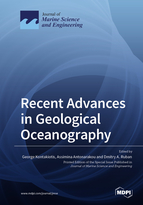Recent Advances in Geological Oceanography
A special issue of Journal of Marine Science and Engineering (ISSN 2077-1312). This special issue belongs to the section "Geological Oceanography".
Deadline for manuscript submissions: closed (10 September 2022) | Viewed by 64291
Special Issue Editors
Interests: marine geology; climate changes; paleoceanography; geochemistry; petroleum geology; basin analysis; sapropels; coastal and open marine systems; environmental reconstruction; marine sediment dynamics
Special Issues, Collections and Topics in MDPI journals
Interests: paleoclimatology; paleoceanographic proxies; micropaleontology; integrated stratigraphy; marine geology; ocean dynamics; sea-level changes; marginal seas; astronomical frequencies in paleoclimates; extreme geological events
Special Issues, Collections and Topics in MDPI journals
Interests: stratigraphy; paleontology; tectonics; management of natural and mineral resources; geoconservation; geotourism; ecological law and climate change policy at local, national, and international levels
Special Issues, Collections and Topics in MDPI journals
Special Issue Information
Dear Colleagues,
Geological oceanography has remained an important direction of international research, and the related investigations have significantly extended our understanding of the marginal seas and open oceans. On the one hand, these investigations add a geological time dimension to oceanography. On the other hand, they facilitate tracing the links between water objects and solid Earth, its dynamics, and life evolution. The scope of this Special issue includes (but is not limited to): marine geology, palaeoceanographic reconstructions and modeling, living and ancient marine organisms of all groups and ages, tectonic evolution of marine settings, marine geophysics and geochemistry, deep sea sediments, coastal processes, ocean dynamics, and marine resources (ores, hydrocarbons, and geoheritage). Topics such as stratigraphical correlations, geological hazards, and human influence as a geological force (if linked to marine environments) also fit the scope of this Special Issue. The freshest, most methodologically innovative and internationally appealing contributions are welcomed. These can be both global and regional in scope, and these can deal with all time periods—from the Archean to the Quaternary. It is expected that these research and review papers will mark the recent advances in the geological oceanography and indicate new ideas, problems, and ways of investigation.
This will be a dynamic Special Issue, and articles will be published as soon as the Reviewers and Editors are ready to accept them, without waiting for the deadline for the entire Special Issue to arrive.
Dr. George Kontakiotis
Prof. Dr. Assimina Antonarakou
Dr. Dmitry A. Ruban
Guest Editors
Manuscript Submission Information
Manuscripts should be submitted online at www.mdpi.com by registering and logging in to this website. Once you are registered, click here to go to the submission form. Manuscripts can be submitted until the deadline. All submissions that pass pre-check are peer-reviewed. Accepted papers will be published continuously in the journal (as soon as accepted) and will be listed together on the special issue website. Research articles, review articles as well as short communications are invited. For planned papers, a title and short abstract (about 100 words) can be sent to the Editorial Office for announcement on this website.
Submitted manuscripts should not have been published previously, nor be under consideration for publication elsewhere (except conference proceedings papers). All manuscripts are thoroughly refereed through a single-blind peer-review process. A guide for authors and other relevant information for submission of manuscripts is available on the Instructions for Authors page. Journal of Marine Science and Engineering is an international peer-reviewed open access monthly journal published by MDPI.
Please visit the Instructions for Authors page before submitting a manuscript. The Article Processing Charge (APC) for publication in this open access journal is 2600 CHF (Swiss Francs). Submitted papers should be well formatted and use good English. Authors may use MDPI's English editing service prior to publication or during author revisions.
Keywords
- Marine Geology
- Paleoceanography
- Paleontology
- Marine Sedimentary Basins
- Oceanic Floor
- Tectonics
- Seismic Stratigraphy
- Marine Geophysics
- Marine Geochemistry
- Coastal Zone
- Offshore Hydrocarbons
- Marine Geoheritage








